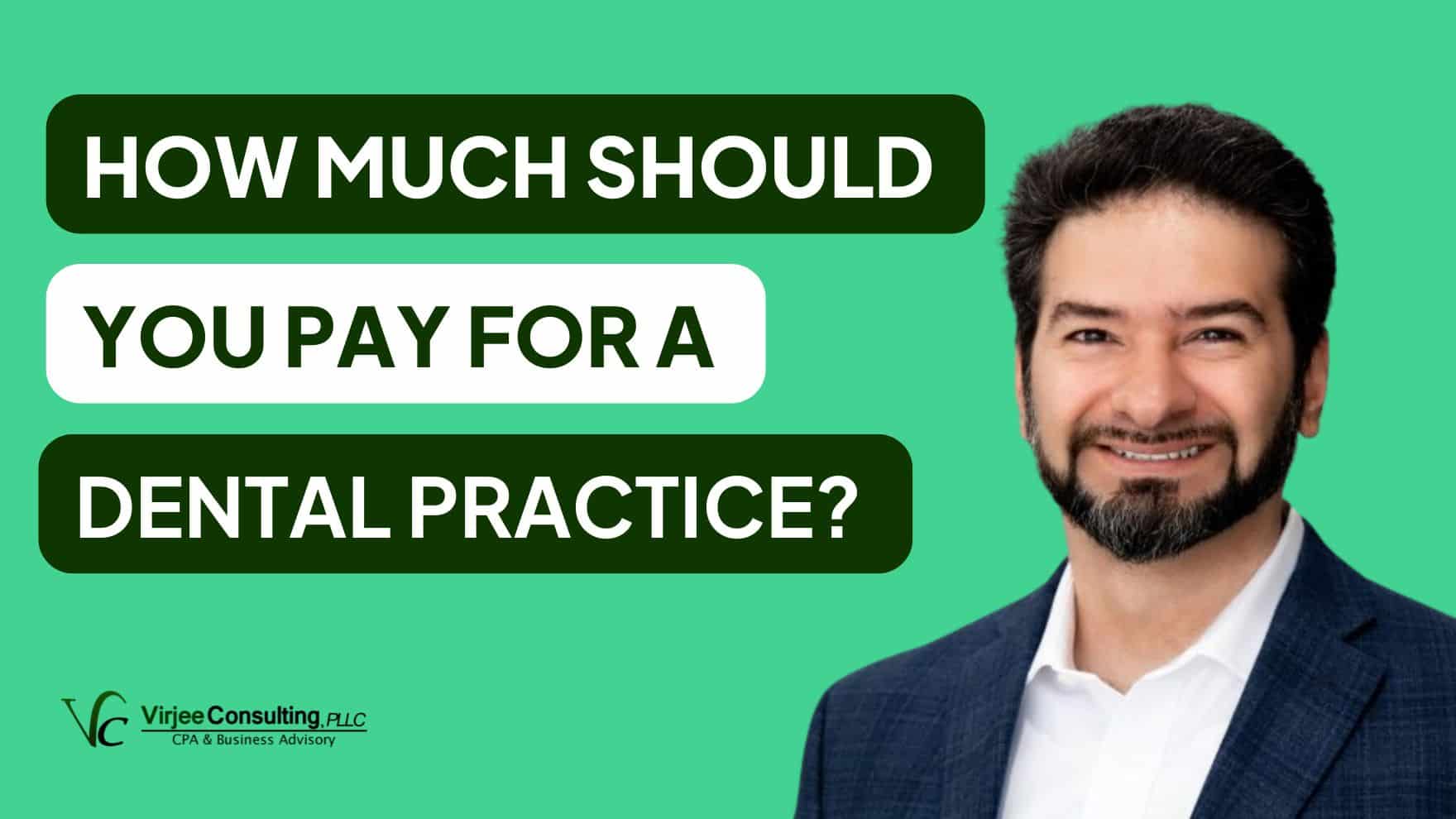If you’re looking to buy a dental practice in 2025, whether it’s your very first or the latest addition to your growing portfolio, you’re probably asking the same question every buyer starts with:
“So… how much is this practice actually worth?”
It’s a simple question, but the answer is anything but.
There’s no magic number, no universal price tag that applies to how much to pay for a dental practice in America.
The right price depends on the practice’s financial health, location, growth potential, and even what kind of dentistry you want to do once you own it.
Let’s walk through what actually determines a fair price in today’s market and how to know if a practice is really worth what the seller is asking.
Start With What Practices Are Selling For in 2025
Let’s talk numbers first.
Most general dental practices in the U.S. are selling for 60% to 85% of their annual collections.
But that range widens when you factor in things like profitability, specialty services, and location.
To give you some context:
- A small practice collecting around $800,000 annually might sell in the $500,000–$650,000 range.
A mid-size practice doing $1.2 million in collections might go for $800,000–$1.1 million.
Larger or specialty practices in major metro areas—think places like San Diego, Chicago, or Miami—can easily push past $2 million or more.
But here’s the thing: collections are just the starting point. What really matters is how profitable the practice is and what kind of income it can generate for you after expenses.
The Real Driver: Cash Flow (Not Just Collections)
We see a lot of dentists fall into the trap of thinking a practice that collects $1 million must be a great buy. But if that same practice is barely breaking even—maybe because of high overhead, outdated systems, or poor scheduling—it’s not nearly as valuable as it looks.
What you’re buying is cash flow.
That’s where the term EBITDA comes in, short for Earnings Before Interest, Taxes, Depreciation, and Amortization. It’s basically the practice’s true operating profit, and it’s a key number in figuring out the value.
In 2025, most practices are selling for 3 to 7 times their EBITDA, depending on how profitable and scalable they are.
So two practices with the same collections can have very different prices—and very different futures—depending on their bottom line. If you’re not digging into the numbers beyond top-line revenue, you could end up overpaying or walking away from a great opportunity.
Location Still Matters, But It’s Nuanced
There’s no denying that location plays a big role in valuation.
A practice in a fast-growing suburb outside Denver or Raleigh might sell at a premium because of rising patient demand and local development.
Meanwhile, a practice in a small rural town in Ohio or Kansas might be listed at a discount, but could come with a very loyal patient base and little competition.
That said, location is more than just geography.
It’s also about:
- Local demographics
- Income levels
- Competition density
- Accessibility and visibility
- Lease terms or real estate ownership
In places like New York City, real estate costs alone can heavily influence what a practice is worth. In others—say, a mid-sized city in the Midwest—the cost structure might be lower, but you’ll want to assess the long-term patient growth potential before jumping in.
Wherever you’re buying, remember: location impacts value, but it doesn’t guarantee success. You still need practice with solid systems, healthy cash flow, and room to grow.
Equipment, Layout, and Capacity for Growth
Let’s say you’re choosing between two practices that both collect $1 million annually.
One has four small operatories with outdated chairs and film X-rays. The other has six fully digital ops with newer equipment, cloud-based charting, and extra space for another hygiene room.
Even if the second practice is priced a bit higher, it may be the better long-term investment. Why? Because you’re not just buying the revenue, you’re buying the ability to scale.
When you’re evaluating the physical side of a practice, ask yourself:
- Is the space efficient and modern?
- Is there room to add another operator or expand hours?
- Are you walking into a full remodel… or something you can grow right away?
Capacity and condition may not show up directly in the financials, but they absolutely affect what you should be paying.
Specialty Services Can Raise the Price, If You Can Sustain Them
Practices offering specialty services – like implants, clear aligners, cosmetic procedures, or IV sedation -often sell at higher multiples because they bring in more revenue per patient.
But here’s a key question: can you continue those services?
If the current doctor is an implant expert and plans to take that skill set with them when they leave, the practice’s production could drop fast unless you or someone on your team is trained to step in.
Always look at the production breakdown by procedure.
If 40% of revenue is coming from a service you don’t plan to offer, that needs to be reflected in the purchase price or in your plan to replace that production.
Don’t Forget the Digital Presence
In 2025, a strong digital presence is part of the valuation.
Practices with great online reviews, high Google rankings, and easy online booking systems tend to bring in new patients more consistently, and that adds real value.
So if you’re comparing two practices that are financially similar but one has hundreds of five-star reviews and the other barely shows up online, you can bet the first one will command a higher price (and rightly so).
But if the practice you’re eyeing is outdated online, that’s not always a deal-breaker. It could be an opportunity, as long as you know how to fix it and have the budget to invest in marketing after the purchase.
Ask What’s Driving the Sale
One of the most underrated parts of any deal is the seller’s motivation.
Are they retiring and winding down gradually?
Burned out and ready to leave ASAP?
Moving out of state for family reasons?
When the seller’s story lines up with the financials and patient flow, you can feel more confident in the deal.
But if you’re hearing a rosy story and seeing declining production, staff turnover, or major holes in their reporting, it’s time to slow down and ask more questions.
Transitions matter. If the seller’s departure will lead to patients or staff leaving, that risk needs to be reflected in the final price.
Financing the Deal in 2025
Most buyers don’t pay cash, and that’s perfectly normal.
In fact, we filmed an entire video with Bank of America about dental financing over on YouTube here.
There are lenders like Bank of America who specialize in dental practice financing, and many will fund 100% of the purchase price if the practice has strong financials and you have a clean credit profile.
SBA loans are another option, especially for first-time buyers or those looking to purchase both the business and the real estate.
What matters most is being prepared. Lenders will want to see:
- Your own financial background
- Your business plan for the practice
- Solid historical financials from the seller
Don’t go it alone here; having a dental-specific CPA or consultant on your team can make a big difference in getting approved and getting the terms you want.
So… How Much Should You Pay?
At the end of the day, the right price is the one that reflects the true value of the practice and what you can realistically earn from it.
There’s no perfect formula. But if you take the time to understand the cash flow, the systems in place, the condition of the facility, and the local market, you’ll be in a much better position to negotiate with confidence.
And remember: this isn’t just about numbers on a spreadsheet. It’s about buying a business that fits your vision, your clinical strengths, and your long-term goals.
Need a second opinion before you buy?
At Virjee Consulting, we help dental professionals across the U.S. make financially smart decisions when buying a practice.
We’ll review the financials with you, help you understand what it’s really worth, and guide you through the purchase so you can walk in on day one with clarity and confidence.
Let’s talk before you sign.
Head over to our contact page to book a free introductory call. We’re always here to help.
Until next time!

